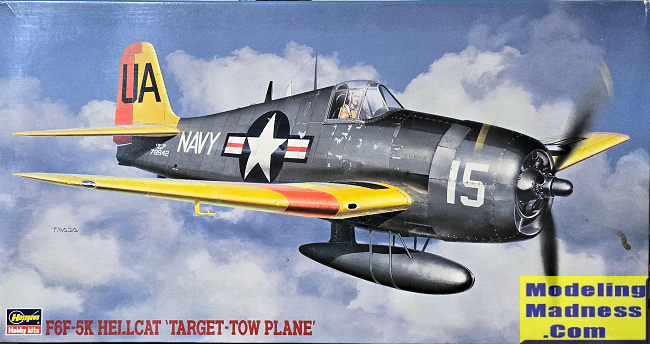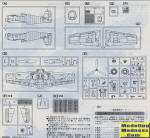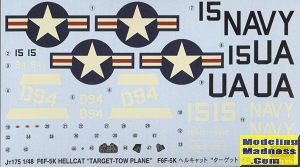
Hasegawa 1/48 F6F-5K Hellcat 'Target Tow Plane"
|
KIT # |
09275 (Jt 175) |
|
PRICE: |
2400 yen when new |
|
DECALS: |
Two options |
|
REVIEW : |
|
|
NOTES: |
1998 limited edition |

|
HISTORY |
Just to put it all in a nutshell, the F6f was undoubtedly the finest all-round American Naval fighter of WW2. Though not as fast as the Corsair, it was ideal for its role at sea. It was fast enough to defeat it's enemies, heavily armed with 6 .50 cal machine guns, easy to fly, easy to land and it was a tough aircraft that could take a lot of damage.
Designed in late 1941, some of the design was influenced by the A6Ms that were captured during the early months of the war, especially its excellent maneuverability. The Navy was so confident in the design that it was ordered into production before the prototype flew. The aircraft achieved the best kill ratio of any Naval fighter before or since at 19:1. Once the war was over, unlike the Corsair, the Hellcat was quickly removed from the inventory and scrapped in huge numbers. Today there are a few in museums and a few are still flying as warbirds.
|
THE KIT |
 Dated 1998,
this is one of Hasegawa's more recent vintage kits. Detailing is everything one
would expect from a modern kit. Excellent engraved detailing, a complete cockpit
with all the appropriate knobs and switches and a two piece canopy. It will be difficult to
display the cockpit open as the canopy is too thick to fit on the fuselage
spine. Items that are with this kit that are not with the similar F6F-3 are
rockets and the wing stubs for them. Should you wish, an F6F-3 can be made from
all the parts in the kit, though you would be on your own for decals.
Dated 1998,
this is one of Hasegawa's more recent vintage kits. Detailing is everything one
would expect from a modern kit. Excellent engraved detailing, a complete cockpit
with all the appropriate knobs and switches and a two piece canopy. It will be difficult to
display the cockpit open as the canopy is too thick to fit on the fuselage
spine. Items that are with this kit that are not with the similar F6F-3 are
rockets and the wing stubs for them. Should you wish, an F6F-3 can be made from
all the parts in the kit, though you would be on your own for decals.
The kit will also require a number of areas to be filled and some small areas to be removed, all of this is shown in the instructions. Also required is to make a pair of blade antennas for the upper spine of the first option. This option is actually a drone controller as drones did not require the two additional antennas on the spine.
 Instructions
are well done and provide the usual Gunze paint references. Two options are
provided. One is the box art plane in dark grey, yellow, and red from VU-1 in
1959. The other is an overall red plane with a black anti-glare nose panel from
Chincoteague, Virginia in 1948. Decals are nicely printed but are old school
where the whites are actually an off white. You can build a standard F6F-5 with
this kit, but will need your own aftermarket decals for it.
Instructions
are well done and provide the usual Gunze paint references. Two options are
provided. One is the box art plane in dark grey, yellow, and red from VU-1 in
1959. The other is an overall red plane with a black anti-glare nose panel from
Chincoteague, Virginia in 1948. Decals are nicely printed but are old school
where the whites are actually an off white. You can build a standard F6F-5 with
this kit, but will need your own aftermarket decals for it.
In conclusion, it makes into a nice kit, though to be honest, so did the older Otaki kit (though it was not a -5). Since this was released, Eduard has brought out a very nice Hellcat, but it is also a fairly fiddly kit with lots of small parts. A plus for the Eduard and Otaki kit is that they have the sharper lower cowling intakes. The ones on the Hasegawa kit are more rounded.
June 2024
Copyright ModelingMadness.com. All rights reserved. No reproduction in part or in whole without express permission from the editor.
If you would like your product reviewed fairly and fairly quickly, please contact the editor or see other details in the Note to Contributors.